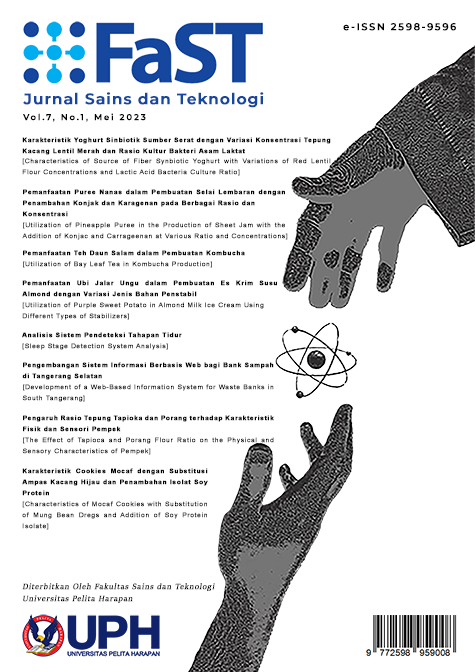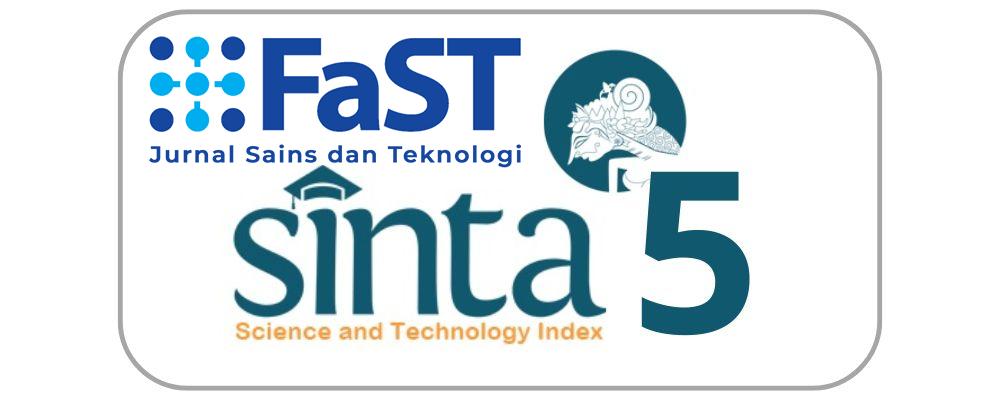ANALISIS SISTEM PENDETEKSI TAHAPAN TIDUR [SLEEP STAGE DETECTION SYSTEM ANALYSIS]
DOI:
https://doi.org/10.19166/jstfast.v7i1.6702Keywords:
babies, EEG, sleep tracker, sleep activity, NREMAbstract
The COVID-19 pandemic has forced some parents to work at home while taking care of their children and taking care of household chores without the help of relatives, housemaids, or nurses. The demands of doing many jobs at once can result in parents, especially parents with babies, being careless in supervising their babies. One of the moments that make parents careless in supervising their babies is when parents suspect the baby is sleeping, because at that moment parents are usually busy doing other chores. With a system that can detect baby's sleep activity, especially detecting stage one, also called NREM (non-rapid eye movement) stage 1, where a person is almost awake, this risk can be minimized because parents can know when the baby is about to wake up and supervise before the baby is fully awake. This study analyzes the ability of two devices, namely, EEG (electroencephalogram) and a smart watch with a sleep tracker feature, as tools for detecting sleep activity of the research subject, specifically detecting stage 1 of the subject’s sleep cycle. In this study, CCTV was also used to find out when the subject was awake. The results of this study indicate that both tools can detect when the subject is awake. Between the two tools used, there was a higher match between CCTV (Closed Circuit Television) footage and the smart watch sleep cycle diagram. For the analysis of the transfer of stages before the subject awakens, the stage that most often becomes the stage before awakening is Light, which is 69.2% for detection with EEG and 76.1% for detection with smart watch. And what rarely happens is moving the sleep stages from Deep to waking up, which is 0% for detection with EEG and 2.3% for detection with smart watch.
Bahasa Indonesia Abstract:
Pandemi COVID-19 mengharuskan beberapa orang tua bekerja di rumah sambil menjaga anak dan mengurus pekerjaan rumah tangga tanpa bantuan sanak saudara, pembantu rumah tangga, ataupun suster. Tuntutan mengerjakan banyak pekerjaan sekaligus dapat mengakibatkan orang tua, khususnya orang tua dengan bayi, lengah dalam mengawasi bayinya. Salah satu momen yang membuat orang tua lengah dalam mengawasi bayinya adalah ketika orang tua menduga bayinya sedang tidur, karena di momen itu biasanya orang tua paling leluasa untuk mengerjakan pekerjaan yang lain. Dengan sistem yang dapat mendeteksi aktivitas tidur bayi, terutama mendeteksi tahap satu, yang disebut juga dengan NREM (non-rapid eye movement) stage 1, dimana seseorang sudah hampir bangun, risiko tersebut dapat diminimalkan karena orang tua dapat mengetahui ketika bayinya sudah akan terbangun dan mengawasi sebelum bayinya sepenuhnya bangun. Penelitian ini menganalisa kemampuan dua buah alat yaitu, EEG (electroencephalogram) dan smart watch dengan fitur sleep tracker, sebagai alat pendeteksi aktivitas tidur dari subjek penelitian, khususnya mendeteksi tahap 1 dari siklus tidur pada subjek penelitian. Pada penelitian ini digunakan juga CCTV (Closed Circuit Television) untuk mengetahui kapan subjek penelitian sepenuhnya bangun. Hasil dari penelitian ini menunjukkan kedua alat dapat mendeteksi saat subjek terbangun. Di antara kedua alat yang dipakai, didapatkan kesesuaian yang lebih tinggi antara rekaman CCTV dan diagram siklus tidur smart watch. Untuk analisa perpindahan tahapan sebelum subjek penelitian terbangun, tahapan yang paling sering menjadi tahapan sebelum terbangun adalah Light yaitu sebanyak 69,2% untuk pendeteksian dengan EEG dan 76,1% untuk pendeteksian dengan smart watch. Dan yang paling jarang terjadi adalah perindahan tahapan tidur dari Deep kemudian terbangun, yaitu 0% untuk pendeteksian dengan EEG dan 2,3% untuk pendeteksian dengan smart watch.
References
Agran, P. F., Anderson, C., Winn, D., Trent, R., Haynes, L. W., & Thayer, S. (2003). Rates of pediatric injuries by 3-month intervals for children 0-3 years of age. Journal of Pediatrics, 111(6), 683-692. https://doi.org/10.1542/peds.111.6.e683
Anam, A. K., Mulyadi, A., & Sagar, D. W. (2017). Upaya orang tua dalam pencegahan cedera anak balita di rumah. Jurnal Ners dan Kebidanan, 4(1), 12-16. https://doi.org/10.26699/jnk.v4i1.ART.p012-016
Atak, N., Karaoğlu, L., Korkmaz, Y., & Usubütün, S. (2010). A household survey: unintentional injury frequency and related factors among children under five years in Malatya. Turkish Journal of Pediatrics, 52(3), 285-293.
Fitbit. (2022). Understand the Impact of Your Sleep. Retrieved March 22, 2023 from https://www.fitbit.com/global/us/technology/sleep
Martin, J. L., & Hakim, A. D. (2011). Wrist actigraphy. Chest, 139(6), 1514-1527. https://doi.org/10.1378/chest.10-1872
Mishra, A., Bhateja, V., Gupta, A., Mishra, A., & Satapathy, S. C. (2019). Feature Fusion and Classification of EEG/EOG Signals. In Wang J., Reddy G., Prasad V., Reddy V. (Eds). Soft Computing and Signal Processing. Advances in Intelligent Systems and Computing. Springer.
Muse. (2022). Muse 2 Starter Guide. Retrieved March 22, 2023 from https://choosemuse.com/blog/muse-2-starter-guide/
Ong, A. C. W., Low, S. G., & Vasanwala, F. F. (2016). Childhood injuries in Singapore: Can local physicians and the healthcare system do more to confront this public health concern? International Journal of Environmental Research Public Health, 13 (7). https://doi.org/10.3390/ijerph13070718
Patel, A. K., Reddy, V., Shumway, K. R., & Araujo, J. F. (2022). Physiology, Sleep Stages. StatPearls.
Schupp, M., & Hanning, C. D. (2003). Physiology of Sleep. BJA CEPD Reviews, 3(3), 69-74. https://doi.org/10.1093/bjacepd/mkg069
Tatum, W. O., Dworetzky, B. A., & Schomer, D. L. (2011). Artifact and recording concepts in EEG. Journal of Clinical Neurophysiology, 28(3), 252-263. https://doi.org/10.1097/wnp.0b013e31821c3c93
Downloads
Published
Issue
Section
License
“Authors who publish with this journal agree to the following terms:
1) Authors retain copyright and grant the journal right of first publication with the work simultaneously licensed under a Creative Commons Attribution License (CC-BY-SA 4.0) that allows others to share the work with an acknowledgement of the work's authorship and initial publication in this journal.
2) Authors are able to enter into separate, additional contractual arrangements for the non-exclusive distribution of the journal's published version of the work (e.g., post it to an institutional repository or publish it in a book), with an acknowledgement of its initial publication in this journal.
3) Authors are permitted and encouraged to post their work online (e.g., in institutional repositories or on their website). The final published PDF should be used and bibliographic details that credit the publication in this journal should be included.”





